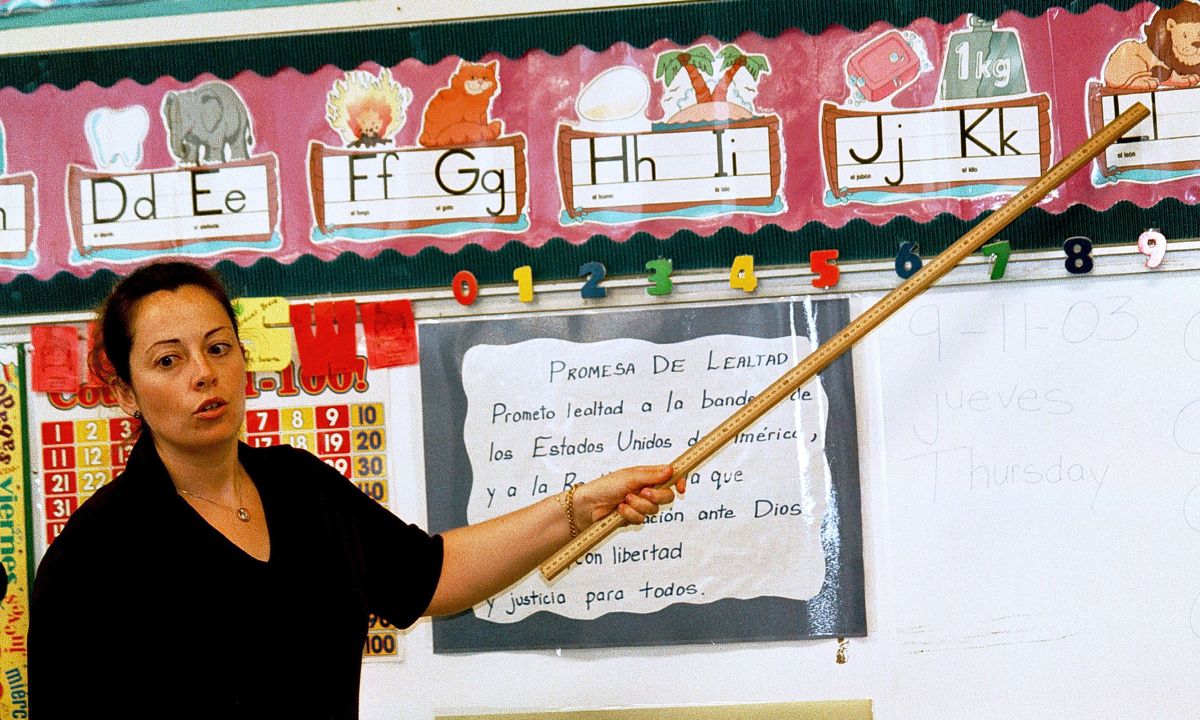To Close the Latino Student Success Gap, Open Up the Educator Pipeline
Fernandez and Bryson: When Latino students have teachers with the same background, it creates an environment where students can thrive.

Get stories like this delivered straight to your inbox. Sign up for The 74 Newsletter
Recent National Assessment of Educational Progress scores reveal concerning trends for Latino students. While some student groups showed modest improvements in 2024, Hispanic eighth-graders experienced declines across core subjects — dropping 5 points in reading and 3 points in mathematics since 2022. The declines reflect widening disparities between higher- and lower-performing students of all backgrounds.
More than two-thirds of lower-performing students come from historically disadvantaged populations, such as English language learners. With English learners projected to make up 25% of students by 2025 — and 76.4% of those being Spanish speakers — it’s time to remove the barriers hindering Latino students.
A key factor holding back Latino students academically is that educators rarely mirror the demographics of schools. When Latino students have teachers with the same background, these teachers reflect the same culture as students, creating an environment for students to have their identity affirmed. Research links exposure to minority teachers to improvements in attendance and achievement.
Latino students now represent 29% of pre-K to 12 students across the U.S., yet only 9% of teachers identify as such. At the same time, teacher candidates of color encounter obstacles to entering and staying in the classroom.
Four critical areas need to be addressed to strengthen the Latino educator pipeline: financial support, strategic recruitment, professional networks and culturally responsive practices.
First, financial support must be enhanced at crucial points in educators’ careers. Competitive salaries that allow for a middle-class lifestyle — combined with loan forgiveness programs, scholarships and performance bonuses — can make teaching more attractive as a career path for Latino educators.
Second, Latino educator recruitment requires strategic workforce development approaches similar to those used in other fields. For example, the Tulare County Office of Education in California has been administering the Teacher Residency for Rural Education Project since 2019, preparing single-subject teachers who focus on STEM and English to meet the needs of local rural school districts.
“We strive to mirror the student population of the schools we serve and implement grow-your-own programs for preparing local talent as educators in our communities,” explained Marvin Lopez, executive director of the Tulare County Office of Education. All schools in partner districts have a higher population of socioeconomically disadvantaged, Hispanic/Latino and English learners than the state overall. On average, 68.2% of learners qualify for free/reduced lunch rates, 49.2% are Hispanic/Latino and 15% English learners.
Research conducted by the Wheelock Education Policy Center on behalf of MassINC in partnership with Latinos for Education recommended a similar initiative in Massachusetts. The study found that while Massachusetts doubled the number of teachers of color hired from 2012 to 2022, students of color increased at a faster rate, leading to a larger gap in representation.
According to the report, “a homegrown strategy to close gaps in college access and success could have considerable impact.” The researchers also noted that if new hires reflected student demographics, by the end of the decade, the percentage of teachers of color would double — from 10% today to about 23% by 2030.
Third, robust support systems and professional networks for Latino educators are essential for their success and longevity in the profession. Only 57% of Hispanic teacher candidates pass the Praxis exam even after multiple attempts, while 75% of white candidates ultimately pass. Supporting test preparation for Latino teacher candidates can make a big difference in addressing this hurdle.
A 2024 research partnership between ETS®, Study.com and TEACH demonstrated significant improvements in exam pass rates through test prep. The study showed that, with sufficient support, teacher candidates from historically marginalized backgrounds experienced meaningful increases in pass rates. This focus on certification support represents one step toward building a more representative teacher workforce.
Supporting professional growth is also essential. Latinos for Education’s Aspiring Latino Leaders Fellowship offers one solution, giving Latino education leaders culturally responsive professional development to envision long-term careers in education rather than temporary positions. There’s always room for more organizations to help keep these vital teachers in classrooms.
These support systems should provide opportunities for leadership advancement, professional development and mentorship connections that understand the unique challenges Latino educators face when navigating school systems.
Fourth, promoting culturally responsive practices that reflect student communities helps retain Latino teachers and improves educational outcomes. It’s not just schools and administration that must address this challenge. Family and community support are vital to expanding the Latino educator pipeline.
One huge asset in this population’s favor: Nine out of 10 Latino parents see high-quality public schools as instrumental to their child’s success, according to a Latinos for Education survey of Houston-area parents.
The same Houston survey uncovered strong support for more teachers who can bridge language and cultural divides. A striking 80% of Latino parents said they would become more involved if more Spanish-fluent educators were present. And teachers see similar value in family support: A Study.com survey of 700 teachers found that 87% believe increased parent and family engagement is the most impactful way to close student learning gaps.
Schools that incorporate culturally responsive curriculum and ensure staff composition reflects student demographics create environments where Latino educators feel valued rather than isolated. These practices also benefit students directly by exposing them to varied perspectives and teaching approaches.
The declining academic scores of Latino students require urgent action. Increasing Latino teacher representation offers a powerful long-term solution. When students see educators who share their cultural background and experiences, achievement gaps begin to close.
Financial support enhancement, strategic recruitment, robust support networks and culturally responsive practices will strengthen the Latino educator pipeline. As more Latino teachers serve as “mirrors” for Latino students, academic outcomes can improve, creating better learning environments for all students.
Get stories like these delivered straight to your inbox. Sign up for The 74 Newsletter

;)

